From The CRPG Addict
United States
New World Computing (developer and publisher)
Date Started: 5 March 2020
Date Finished: 1 May 2020
Total Hours: 55
Difficulty: Hard (4/5)
Final Rating: (to come later)
Ranking at time of posting: (to come later)
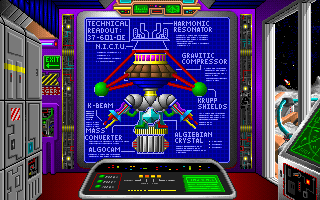 |
| The device is almost together. |
 |
| Is this species any of the aliens I met on the worlds’ surfaces? |
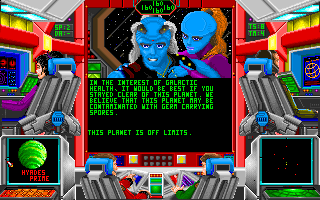 |
| Will someone please tell me who these guys were? |
You’ll recall that the game’s central plot involves the mysterious disappearance of the Earth. Since its gravity well doesn’t also disappear, it seems that the Earth hasn’t been so much destroyed as somehow occluded. At the same time, an alien ship crash-lands on the Moon, and scientists on the Moonbase determine that a device on the cash, which they name the “Centauri Device,” was responsible for the vanishing of the planet. They identify eight crucial pieces that they need to get it working and reverse the effects. Studies of the craft allow humanity’s remnants to make enormous technical leaps (including faster-than-light travel), and soon the player and his party of four are commissioned to head off into the galaxy and beg, steal, borrow, or barter for the eight parts, of which there is one in each of eight sectors. They also need to find six sets of ships’ plans and four sets of technical plans to improve their ship and personal items.
As I said, the game is less concerned with the overall plot than the individual troubles of each Sector. Each one has four or five inter-related stories. You largely find them by searching random systems until you find one, and then following clues from that one to the others. (Or, you could be a lunatic and visit every system and every planet and record where they occur before visiting them.) But the game really starts at Alpha Centauri, where you find an observation base set up by the aliens performing the Centauri Device experiment. It was later attacked by another species. A brief summary each sector:
- In Sector Algieba, the saurian President Ishtao has been re-elected and is hosting his second inauguration ceremony. The event has been infiltrated by a group of terrorists called the Geal A’nai who you can either work with or foil. (Or you can just kill everyone.) But to get into the palace, you first have to solve some problems on a couple of Ishtao’s constituency worlds until the leader of one of them passes you an invitation. The Geal A’nai are trying to influence events on those worlds, too. I thought they would ultimately become a presence throughout the game, but they’re only in that sector.
- Sector Alhena is in the midst of a civil war between the Scroe and the Evian, while a third race called the Dhoven try to mediate. Most of the episodes take place on war-torn planets in which the party has to fight both Scroe (look like Bossk) and Evian parties while obtaining help from Dhoven NPCs (white, gangly things). However, if you know what you’re doing (because you read the cluebook), you can bypass three of the scenarios, go directly the peace conference on Hyades Prime, and kill everyone to get the needed device part, the Krupp Shields. This option is quite evil because you end up literally massacring a group of envoys sitting around a peace table. One wonders if that ends the peace process or causes the Scroe and Evian to unify in their hatred of Earth.
 |
| “Good luck with that whole peace thing!” |
- Sector Alnasl is home to the Ominar, a species that looks like it has a bulbous red head. They reproduce by cloning and the uploading “standardware” into the brains of their clones, but this standardware has lately been sabotaged by a race or faction called the Ipremi Secundus (they look pretty much just like the Ominar), leading to rampant insanity among Ominar citizens. You have to help (or just kill) the Ominar to get the various items needed to invade the Secundus Base (easily the hardest episode in the game) and find the needed Algo Cam.
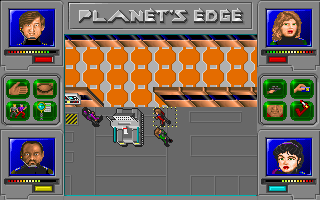 |
| Fighting these enemy robot tanks on Secundus Base was the hardest melee part of the game. I must have reloaded 25 times. |
- Sector Ankaq has a few species, but the most relevant is the antlike Ethnys, whose queen rules from Ankaq Prime. You have to find four spheres among the other planets and bring them back to Ankaq Prime to, I don’t know, bring the species back into harmony again and make it possible for the queen to continue laying eggs. These spheres are scattered about the other episodes, including one where the entire party dons wetsuits and visits a triton-like species called the Tschi Tai and another where they have to fight through an urban wasteland called Shadowside. The grateful queen gives you the Harmonic Resonator.
 |
| Placing the orbs around the hive. |
- Sector Caroli is the one with a plant-based species called the Eldarin. They hibernate for long periods, awaken ravenously hungry, and must eat immediately. But their food distribution system has lately been disrupted, so you’ve got to run around fixing tractors and stuff to save them from their own incompetence. The Ominar have been supplying the Eldarin with parts, and the scenarios end on an Ominar base, where you find the Gravitic Compressor.
- Sector Izar is the most confusing. The way I understand it is that the natives are actually human. You visit one planet, Arcturas III, which feels like a fantasy RPG complete with archers, kings, princesses, and a castle. But the sector has been invaded by the Ipremi Secundus whose leader, known as The Concierge, has built a supercomputer called OMEGA to oversee the sector. OMEGA for some reason has ordered the kidnapping of the more primitive aliens from their planets, and one of those races, the Mizarans, are currently rebelling. You have to collect a bunch of Hataphas Gems from various worlds before finding your way through an invisible maze on Izar II to confront the Concierge and get the N.I.C.T.U. device from him.
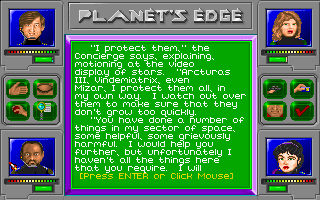 |
| Talking with the Concierge. I’m pretty sure he’s just guessing about the “some helpful, some grievously harmful” part. |
- Sector Kornephoros is an anarchic part of space with a motley group of settlers, scavengers, and pirates. All the planets are being threatened by a species called the Cin Sae, which look like the aliens from Aliens. The central episode is an auction on Kochab II, where the auctioneer has the Mass Converter. You can run around the entire sector solving issues for various people and accumulate the things the auctioneer wants for the part, or you can just walk up, shoot him, take it, and beam away.
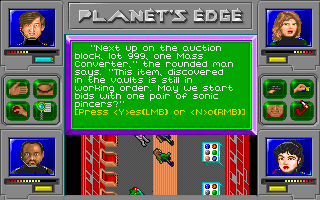 |
| “Sure, but not in the way that you had in mind.” |
- Sector Zaurak is another one that I barely explored. It is inhabited by a humanoid species known as Ranans. The sector has lately been threatened by the appearance of “white hole” (the opposite of a black hole, it spews matter outward instead of sucking it in). On Rana Prime, a leader called the Giate offers you the needed K-Beam if you’ll run around the sector placing “grav buoys” to counter-act the white hole.
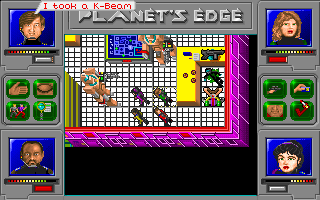 |
| Unfortunately, the Giate made the mistake of telling me he had the K-Beam on his person. |
As far as the main plot goes, the best I can figure is that the Ominar were the ones operating the Centauri Device. It was supposed to give them “transuniversal travel” capabilities, but the Ipremi invaded their outpost on Alpha Centauri, interrupted the experiment, and caused it to go awry. How this ended up affecting the Earth is not technically explained.
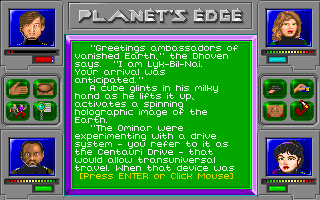 |
| A random NPC imparts more information than anyone else in the game. |
There’s a lot of ground combat across these scenarios, and the annoying thing is that the team never really gets any better because there’s no character development. You can keep re-cloning team members, but even at skill scores of 100 with their respective weapons, characters seem to miss an awful lot. Part of the problem is that you’re always having to swap equipment in and out depending on the enemy. If you’re facing an enemy wearing ceramic armor, you don’t want to be shooting him with laser weapons because ceramic protects against those. So you switch to projectile weapons but have to remember to switch back if you meet someone wearing composite armor. Meanwhile, you’re constantly changing your own armor based on the weapons the enemy is using.
It’s not hard to figure out what armor is the best because it has a hit point value, but it’s not always clear with weapons (until you look at the clue book, that is). And–oh, my god–looking at that table, I just realized that the “tac nuke rifle” is listed as a light weapon not a heavy one. That might explain why I had so much trouble, since I gave those rifles to my heavy weapon characters. Aaargh. Does that sound like a light weapon?! Anyway, the only good news is that weapons of the same type use a common ammo stock so you don’t have to carry 20 different types of ammo around.
Other aspects of melee combat annoyed me. Enemies around corners always seemed to be able to shoot the party even when I couldn’t hit them. They seemed to have a lot more success from farther away, often off-screen, than I did. And I was always getting into combats in the most uncomfortable physical environments, like narrow doorway openings where I had to have my lead characters advance under fire if I wanted my rear characters to be able to participate. I suppose there are other times and other games in which I would have regarded such scenarios as “tactical,” but I’ll tell you what: knowing that I’m not getting any skill or experience from combat really reduces my desire to fight it.
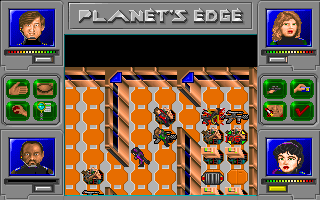 |
| Occasionally, it works out for you. Here, I can use my grenade launcher (which does damage to a 4 x 4 area) to damage the immobile robots, while they can’t even see me. |
Space combat also remained quite hard for me, particularly in the Alnasl and Izar sectors, where just about every planet had an orbiting defense platform and a few ships. I had to use the cluebook to tell me where to find ship’s plans so I could upgrade as quickly as possible, and even then I had problems. One thing that makes life a little easier is that your ship is fully repaired when you disengage from combat, so you can dive in, destroy one enemy, and escape, then repeat for the next one until all are dead. But even that’s pretty tough. Sometimes, you can’t escape because your enemies destroy your engines. And a lot of other times, two or three enemy ships is enough to destroy yours before you can even get their shields down.
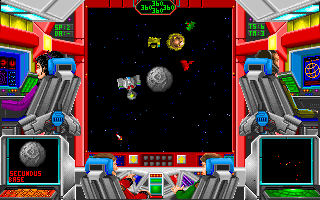 |
| It’s never fun getting to a planet and seeing this. |
The game offers several weapon types for ships. The success of beam, bolts, and projectile weapons is based on character skill. You can also mount missiles which just home in on targets and don’t depend on skill. Either way, I assumed for a while that the key to success was a variety of weapon types. The last two class of ships allow you to max out your 10 weapons slots, so I’d do a couple of rack guns, a couple of megamissile mounts, a couple of quark lasers, and so forth. There are supposedly also a lot of tactics associated with whether you mount the weapons to face forward, left, right, or on a 360-degree turret, the latter taking four times the space as the former three.
When variety seemed to fail me, I spent a lot of time recloning my lead character to favor different weapons. In the end, I found that nothing served me better than loading up all 10 weapon mounts with quark lasers, putting as many on turrets as possible but facing the rest forward. That simple bit of advice early in the game would have saved me a lot of reloading.
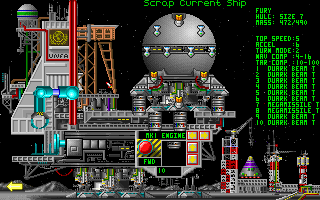 |
| My final ship configuration. |
When you have all eight pieces of the Centauri Device assembled, the endgame commences. An animated series of screens shows Earth scientists re-activating the device, shooting some kind of electromagnetic wad towards the vanished Earth. It strikes, and the Earth dissolves back into view.
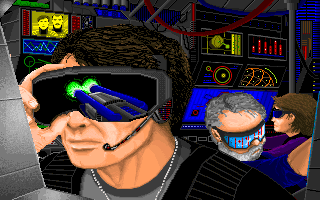 |
| A bunch of scientist guys prepare to use the device. |
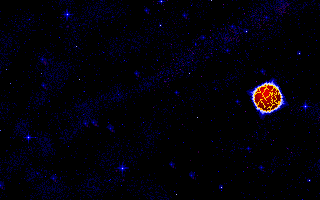 |
| There it goes! |
 |
| This is a very accurate globe. |
A ship heads from Moonbase to Earth, where there’s some kind of big award ceremony. As each crewmember walks up and salutes a man who is presumably the Earth president, a bit of text tells you his or her fate. William Dean ends up marrying Katya Mershova, who later dies on duty. Osai Tsakafuchi becomes the World Health Administrator, and Nelson Ngatadatu simply retires.
 |
| Given that he’s a clone, that’s probably a euphemism. |
After the characters get their honors, key personnel in the development of the game also walk up and salute the president.
 |
| Hyman’s resignation letter. He was at ORIGIN the following year. |
Finally, we get some scrolling text:
And so the Earth was pulled back into this, its proper universe. The U.N.F.A. team that had wandered the far reaches of a galaxy new to mankind returned home as heroes. Knowledge was gained that will forever alter the course of the Earth’s destiny, and contact was made with a galaxy teeming with life. [“And much of that life was destroyed,” it should have said.] Mankind finally grasped the heavens.
But soon afterwards, the “The End” screen develops a question mark, the moon dissolves away, and a message appears on the screen indicating that “the exact time the Earth was released from its dimensional limbo, the Moon slipped through a rift in the time-dimensional barrier.” This is a pretty stupid development, first because if it happened at the “exact time,” the crew, who was still on Moonbase, never would have made it back to Earth. Second, if it’s setting up the sequel, it’s not only derivative but a little lame. Sequels should increase the ante, not lower it. The original game had 8 billion people on the Earth threatened, while the sequel deals with a few thousand on the moon? That’s like Liam Neeson rescuing his daughter only to discover, to his shock, that the kidnappers have now targeted his second cousin, once removed.
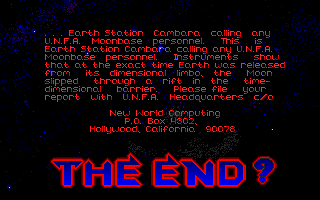 |
| Would the sequel have been called Moon’s Edge? |
A quick GIMLET:
- 5 points for the game world. The plot is original, and there’s some good world-building to balance out the stupid world-building. The game is definitely more in the vein of pulp sci-fi like Buck Rogers than the more grim, realistic sci-fi we’ve become accustomed to today. Nothing wrong with that; it’s just not my particular brand of vodka. I’d give a higher score if the episodes had a greater since of inter-relation, and the choices you made in one had consequences for others. Alas.
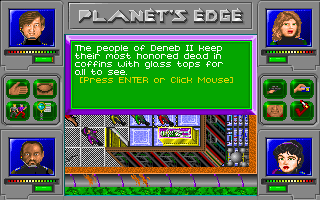 |
| To see them decay? |
- 1 point for character creation and development, if by “creation” you count “cloning.” After that, there’s no development and you can’t even choose their names. New World should have known better.
- 5 points for NPC interaction. There sure are plenty of them, and most of the have at least a half a paragraph of text. NPCs are vital for background information, main quests, and side quests. I just wish you could see them better.
- 4 points for encounters and foes. Enemies aren’t really any fun, more distinguished by the weapons they wield than anything to do with AI or special attacks and defenses. But the game is relatively strong in other encounters and puzzles, only most of which involved inventory items.
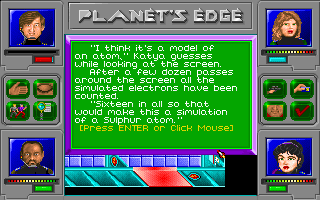 |
| My characters suss out a puzzle that involves pushing buttons to assemble elements into chemicals. |
- 4 points for magic and combat. I didn’t like the system for the reasons I gave above. It would have been vastly improved by actions other than simple shooting. But I do recognize some tactics in both ship and ground combat.
- 3 points for equipment. You sure do get a lot of it, although most of it is for puzzle-solving. Standard RPG fare consists primarily of weapons, armor, and medical kits. There are some interesting exceptions, though, such as a shroud that resurrects slain characters and a pair of boots that let you jump over some obstacles. I like the way that you can replicate any item that you find back at the Moonbase.
 |
| Preparing to don a wetsuit. |
- 2 points for the economy. It doesn’t really have a monetary economy, but your ability to build ships and items is dependent on finding natural resources. These natural resources are traded by ships and used to pay admittance to some planets and extortion from pirates, so they functionally serve as an economy. It’s still not very good, or complex.
- 5 points for quests. I can’t complain that the main quest doesn’t provide alternate paths and role-playing options, and there are lots of side-quests that allow you to get better equipment or just information. My failure to follow all of these probably explains why I’m still confused about so many points in the game.
 |
| The “episode” title cards are always fun, but there’s just too many of them. |
- 3 points for graphics, sound, and interface. This is going to prompt some arguments. It gets most of those points solely from the interface, which is very well done, offering redundant mouse and keyboard commands. However, it loses a point for the pathfinding of the characters on the ground. As for graphics, this is just the sort of 1990s title for which I would prefer black and white iconographic graphics to what we have. There’s simply too much detail for the actual screen resolution, making it hard to tell what the developers were intending to depict on the alien figures, making it nearly impossible to tell objects from furniture, wall tiles from floor tiles, and NPCs from plants (admittedly, my colorblindness may have been a factor). My complaints are only from planetary exploration, though, and the graphics for the Moonbase, animated scenes, and space travel are quite nice. As for the sound, a few good effects are outweighed by an unnecessary piercing beep every time you scroll through a menu. I played with the sound off most of the time.
- 4 points for gameplay. It gets some credit for quasi-nonlinearity (difficulty enforces a general order) and for some replayability given the different ways that you can approach scenarios. But it was too hard and too long. Five parts would have been better.
That gives us a final score of 36, technically just above my “recommended” threshold, but I don’t know that I’d recommend it–not as an RPG. It just doesn’t have enough RPG mechanics to keep itself aloft.
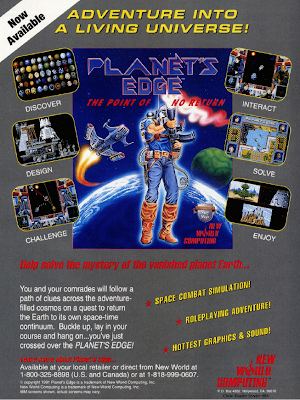 |
| See, the “enjoy” part is where I had trouble. |
Everyone else seems to like it more than I do. Computer Gaming World nominated it for RPG of the year for 1992. (It was up against Eye of the Beholder 2, Might and Magic III, Ultima VII, and Ultima Underworld; Underworld won.) Contemporary reviewers liked the episodic approach as well as the specific content of the episodes. “A solid, charming game with a few lumps in the dough,” proclaimed an oddly anonymous Computer Gaming World writer in July 1992. Scott May, writing in the April 1993 Compute!, called it “a minor masterpiece of size, imagination, and diversity of play.” The June 1992 Dragon gave it four stars but had hardly anything negative to say about it except a few bugs I didn’t experience. No one seemed to be overly bothered by the lack of character development, although a couple of them groused about character creation.
I don’t know if New World really planned for a sequel or if it simply designed every game with a potential sequel in mind depending on sales. Either way, I’ve never seen mention that a sequel was even begun. Outside of publishing several instances of the strategy game Spaceward Ho!, New World stayed away from science-fiction (except for that inherent in Might and Magic) for the rest of its existence. Lead programmer Eric Hyman went to work for the acquired ORIGIN systems but only has credits on the company’s action games before he left for other technology jobs. Neal Hallford still has Betrayal at Krondor (1993), a train derailment (1995), Return to Krondor (1998), and Dungeon Siege (2002) in his future and has never entirely left game development.
It occurs to me that Planet’s Edge has a lot in common with Challenge of the Five Realms, released by MicroProse the same year. Both games are episodic, featuring a bunch of side-quests and multiple paths through them, both with minimal character development and similar approaches to combat. Challenge scored 5 points higher at 41, and I see that I gave it 7 points for the game world compared to Edge‘s 5. I’m prepared to acknowledge that I have a small inherent bias in favor of fantasy games.
Moving on, a random roll of the open 1982-1992 titles produces 1983’s Karkoth’s Keep for DOS, a game that I missed on my first pass but which appeared on MobyGames in 2017. At the far end of the list, I have just added Might and Magic IV (1992), which of course I will play consecutively with Might and Magic V (1993).
Original URL: http://crpgaddict.blogspot.com/2020/05/planets-ege-won-with-summary-and-rating.html

